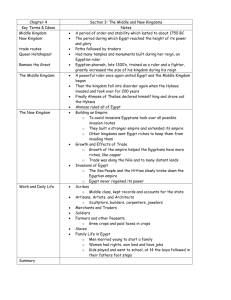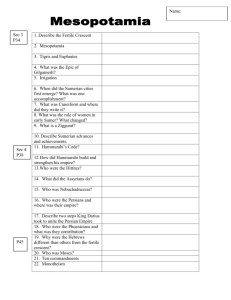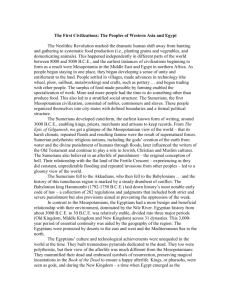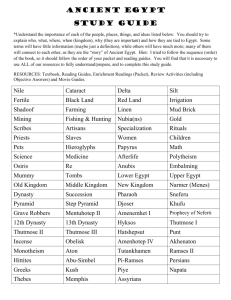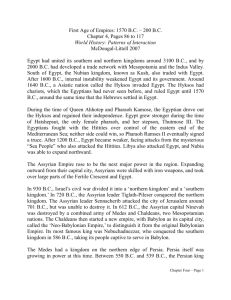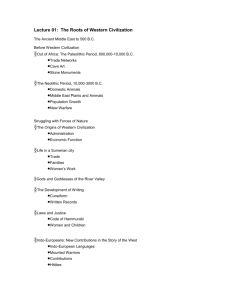First Age of Empires
advertisement
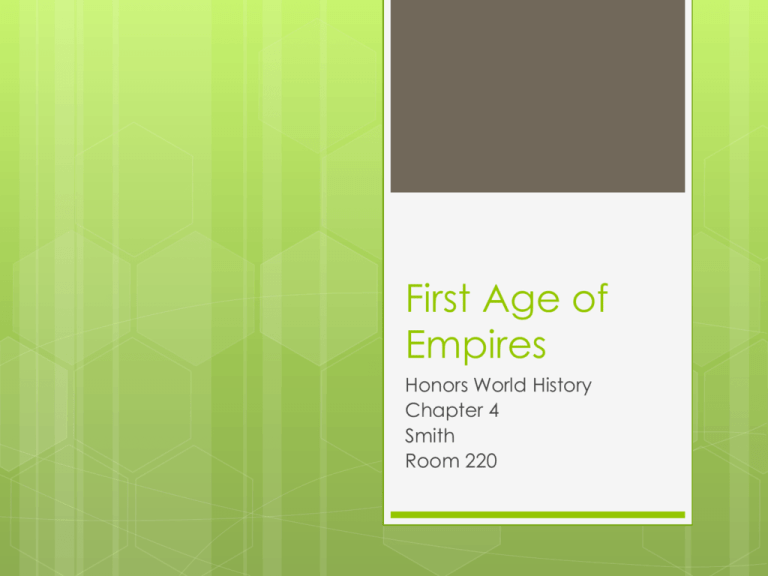
First Age of Empires Honors World History Chapter 4 Smith Room 220 The Empires of Egypt and Nubia Collide Because of weak pharaohs and power struggles between rival nobles, the middle kingdom of Egypt declined. A group of invaders known as the Hyksos ruled Egypt from 1640-1570 BC Queen Ahhotep takes over as Pharaoh when her husband dies in battle. She drives the Hyksos from Egypt. After the Hyksos leave, Egypt begins the New Kingdom in 1570 BC. Both men and women will be pharaohs during the New Kingdom. New Kingdom From 1570 – 1365 BC Under the rule of Thutmose III Egypt’s kingdom will push into Syria and Palestine to the East and Nubia in the south. Rulers of the New Kingdom will build large monuments, palaces, temples and tombs. Many of these will reflect their belief in the afterlife. Ramses II will be the most powerful of the New Kingdom pharaohs. Decline of the Empire After the reign of Ramses II the Egyptians and Hittites were attacked from several groups including the “people of the sea” that are an uncertain group – possibly the Philistines. Egypt will break up into several regional units and various kingdoms independent of each other. Including Kush. Kush/ Golden Age of Meroe In 671 BC the Assyrians force the Kushite royal family to move south to Meroe. Because of its abundant iron ore Meroe became a major center for the manufacturing of iron weapons and tools. As the mineral wealth flowed out, luxury goods from India and Arabia flowed in. After death of a king, the succession of a Kushite king was determined by agreement of the leaders and nobles. Assyria dominates the Fertile Crescent Around 580 BC Assyria acquired a large empire It was through there ability to defeat opponents in battle that they were so successful. Assyria glorified military strength Soldiers were covered in leather and metal armor. Weapons included spears, archers and large shields Assyrian Kingdom Between 850-650 BC the Assyrian Kingdom included Syria, Palestine, Babylonia, the Fertile Crescent and Egypt. The Empire Crumbles As with many empires, Assyria grew too big. Additionally, the Assyrians were very cruel to those they conquered, this caused many to grow as enemies. The Assyrians fell to the Medes and Chaldeans who destroyed the capital city of Nineveh. After defeating the Assyrians, the Chaldeans made Babylon their capital. Around 600 BC it became the center of a new empire under Nebuchadnezzar. Persia Unlike the Assyrians, the Persians would rule from tolerance and diplomacy rather from fear and destruction. In 550 BC, Cyrus conquered several neighboring kingdoms in Iran. The eventual empire would span over 2 thousand miles. Once conquered, Cyrus would show kindness to the vanquished. A great deal of freedom was enjoyed by the people of his kingdom. Persia Rule and Religion After the death of Cyrus, his son extends the Persian empire to include Egypt. However, unlike his father Cambyss scorns the Egyptian religion and has the images of Egyptian gods burned. Rebellion breaks out and the empire is in a rather fragile state. After a short reign, Darius takes over and spends the first few years quelling rebellion in the empire. He then established a well-run and efficient administration Darius’ Rule Darius divides the sprawling empire into 20 provinces. In each province the people are allowed to practice their own religion, speak their own language and follow their own laws. He does, though, install a satrap, or governor in each province as well as a military leader and tax collector. Finally, he issues standard money for all provinces and builds excellent roads connecting the provinces. An Empire Unifies China With the decline of the Zhou Dynasty in around 500 BC, many of China’s values of social order, and respect for authority were cast aside. Philosopher and scholar, Confucius, believed that social order could be restored if society followed through 5 basic relationships… Confucius These 5 basic relationships were 1. Ruler and subject 2. Father and son 3. Husband and wife 4. Older brother and younger brother 5. Friend and friend… He also stressed filial piety by children – respect for parents and elders. Daoists The social order of family and government was very important to Confucius. Another Chinese thinker was Laozi – he believed the only important order was natural. He believed that a natural force called the Dao, “The Way” guides all things. Of all creatures – only humans fail to follow the Dao. His philosophy became to known as Daoism Qin Dynasty The first leader in the new dynasty was 13. He is a surprisingly good emperor He quells much of the internal strife Named Shi Huangdi, he was also good at stopping invading armies and attacked both to the north and the south. He demands that all noble families move to the capital city – uprooting 120,000 families Establishing an Autocracy Has critics murdered Burns books – but spares books on medicine and farming. “Strengthening the trunk and weakening the branches” is his phrase to show his desire for a centralized government. Builds a highway network of 4,000 miles Standardized Chinese writing, establishes official weights and measures including cart axel width. The Great Wall Peasants were forced into labor or suffer the consequence – death. It was a completion of a wall built under the Zhou dynasty Contrary to popular belief – not able to see it from space… End of Qin Dynasty The son of Shi Huangdi was less capable than his father – a trend we will see throughout history… Peasants rebelled just three years into new emperors rule Led by a leader from Han area. Han Dynasty takes over in 202 BCE
